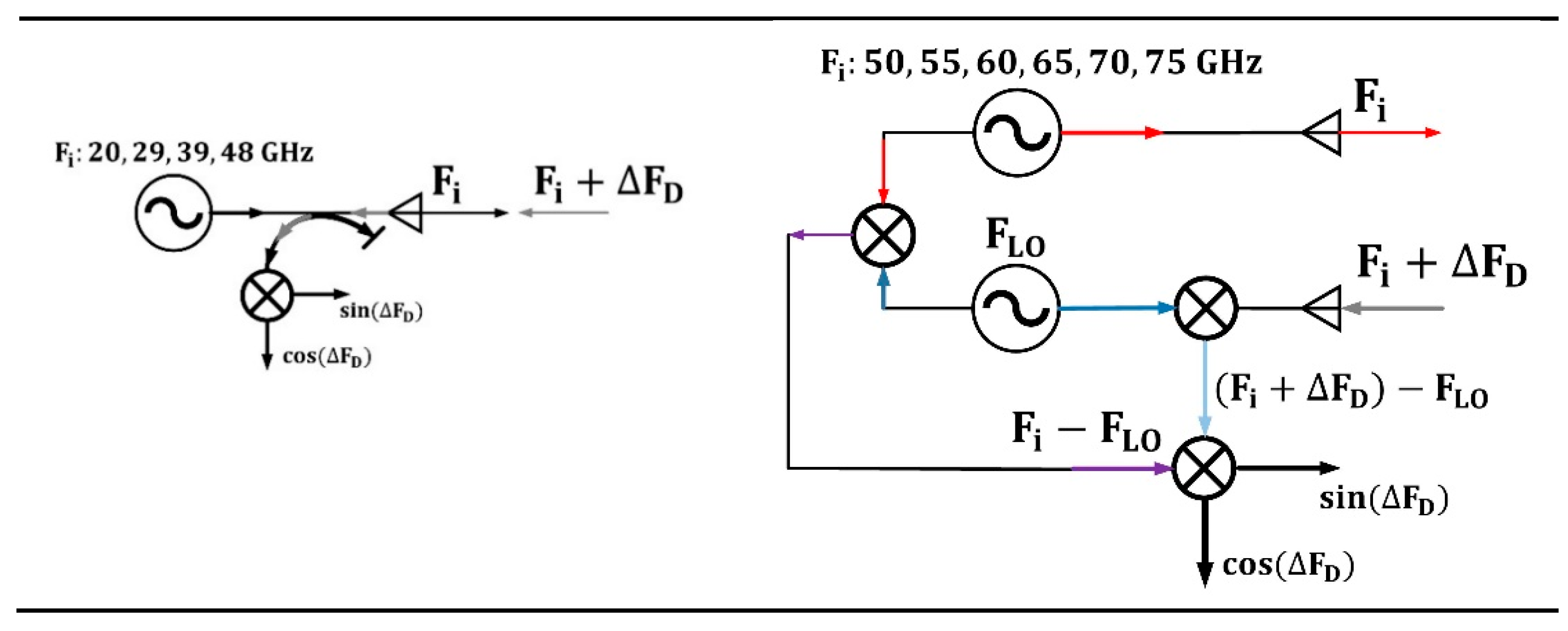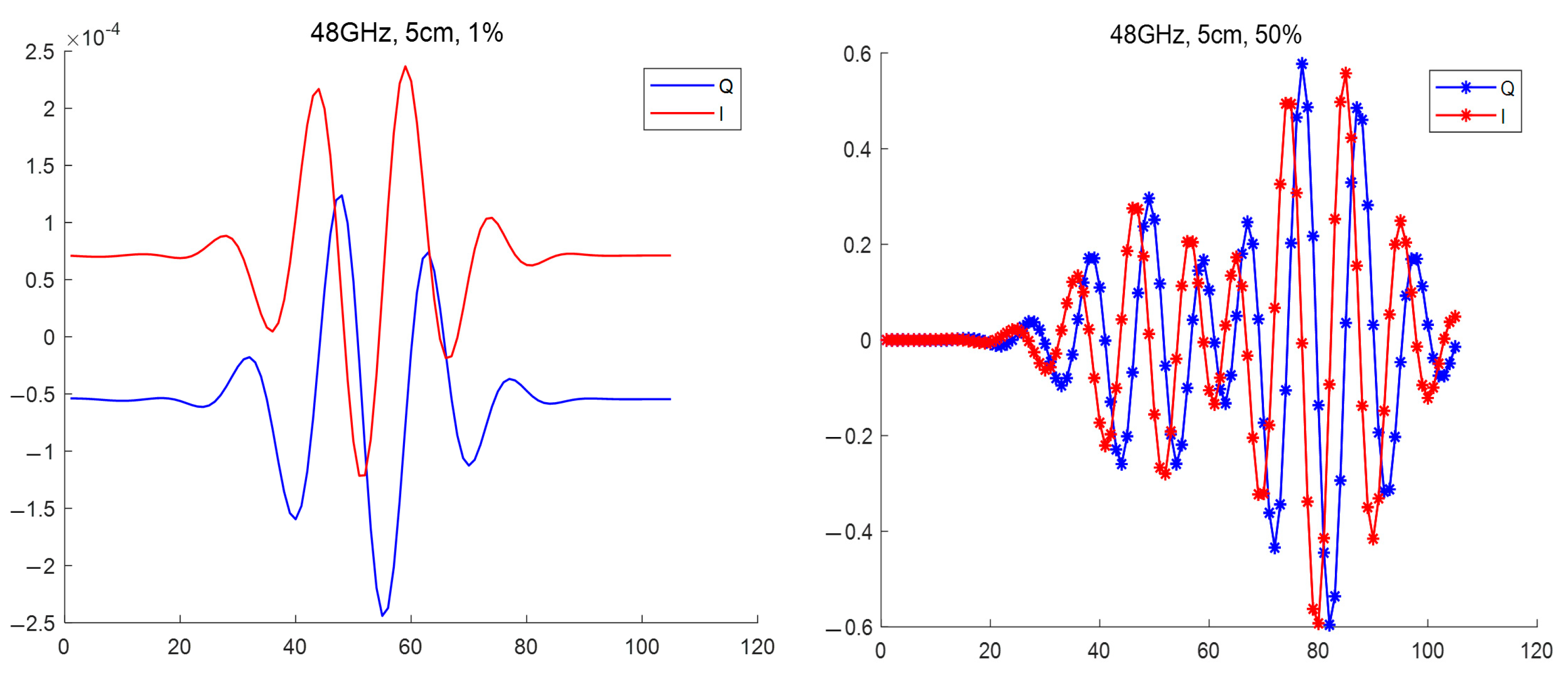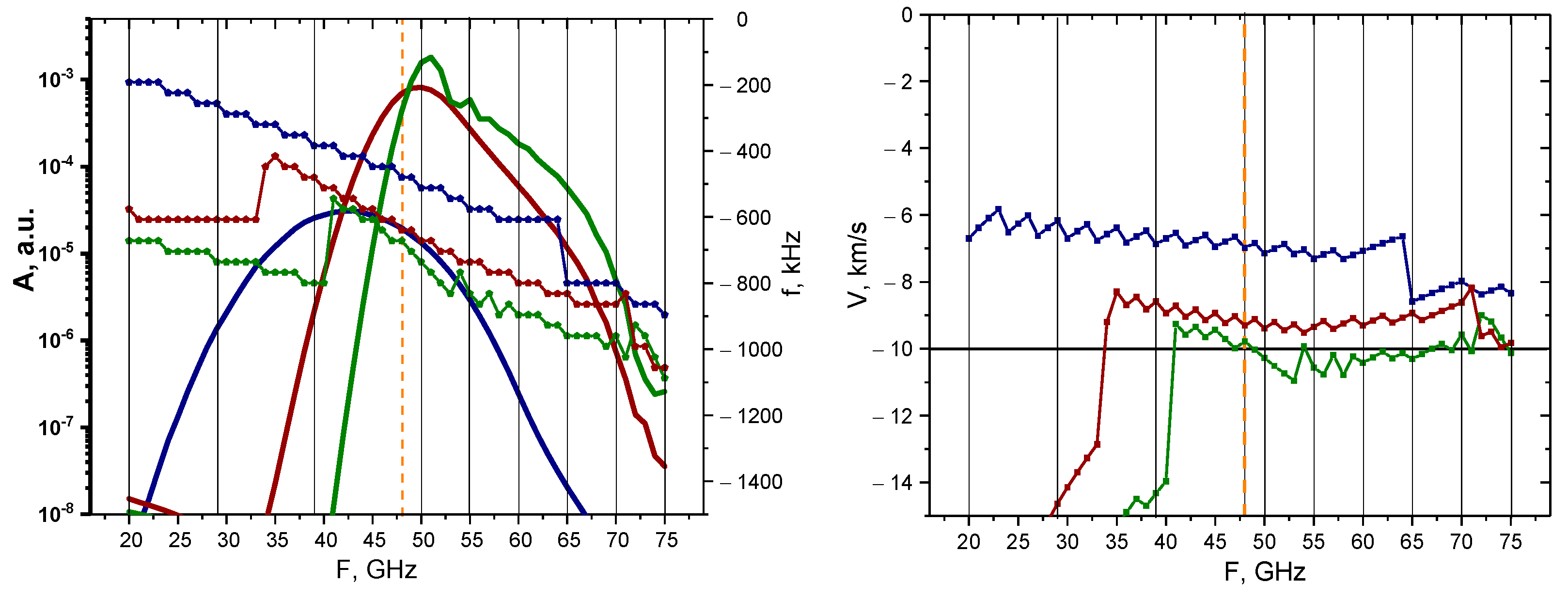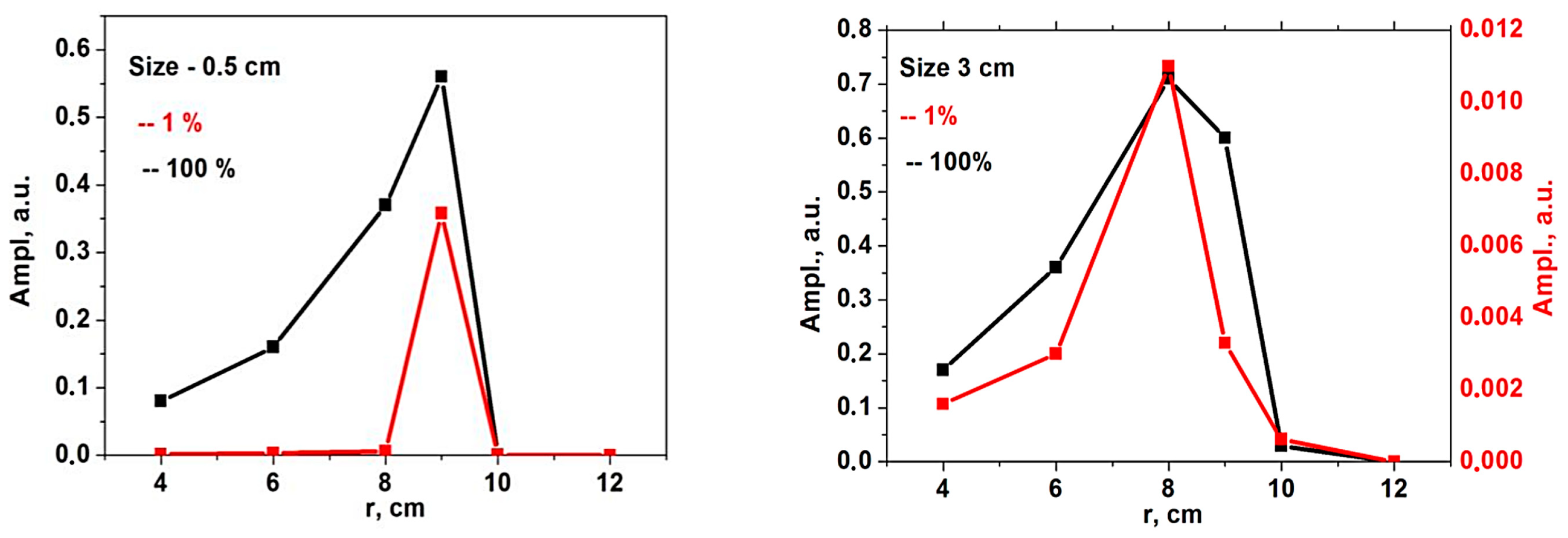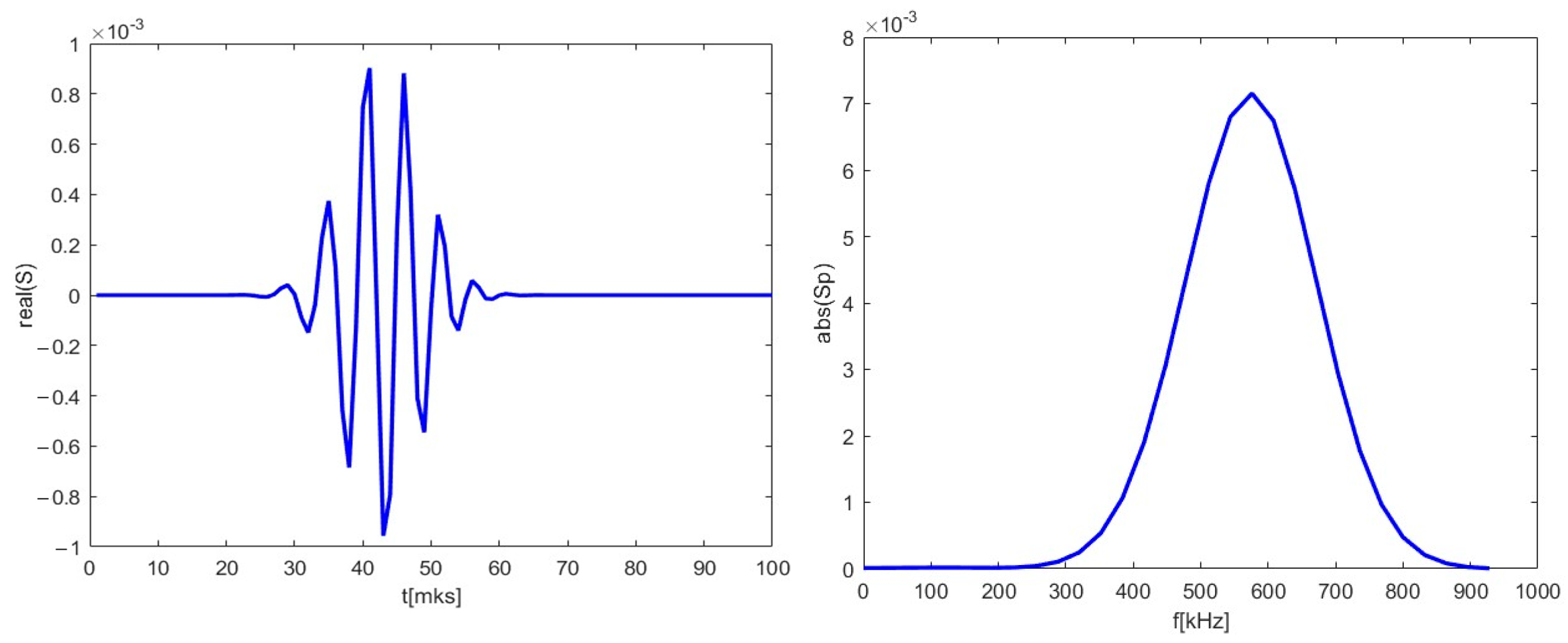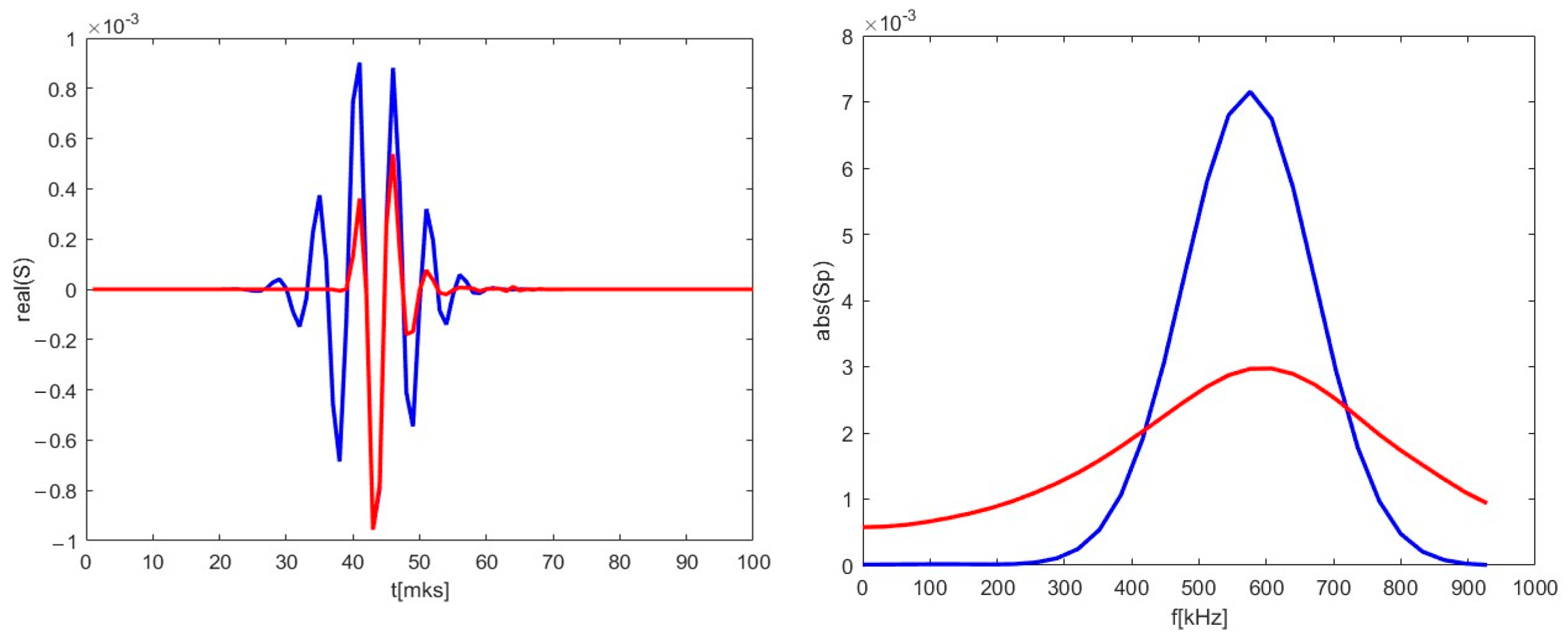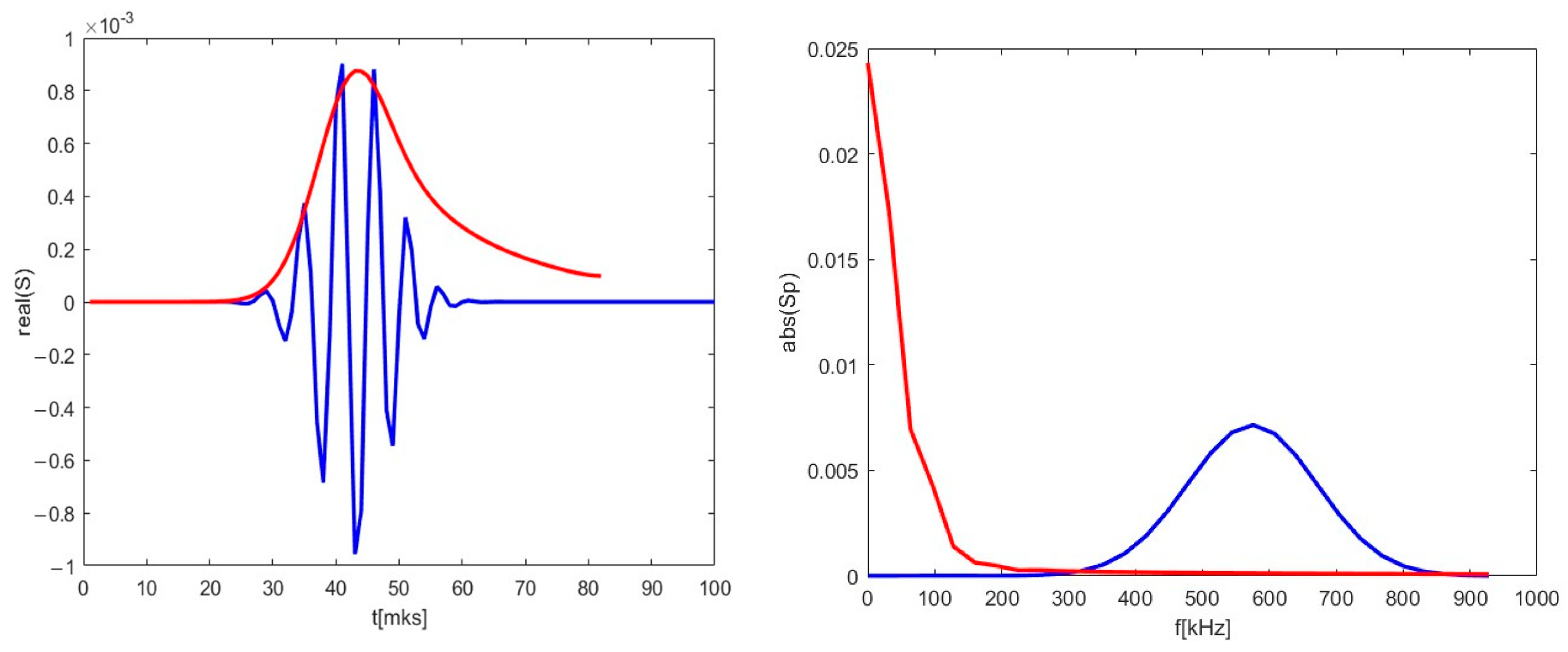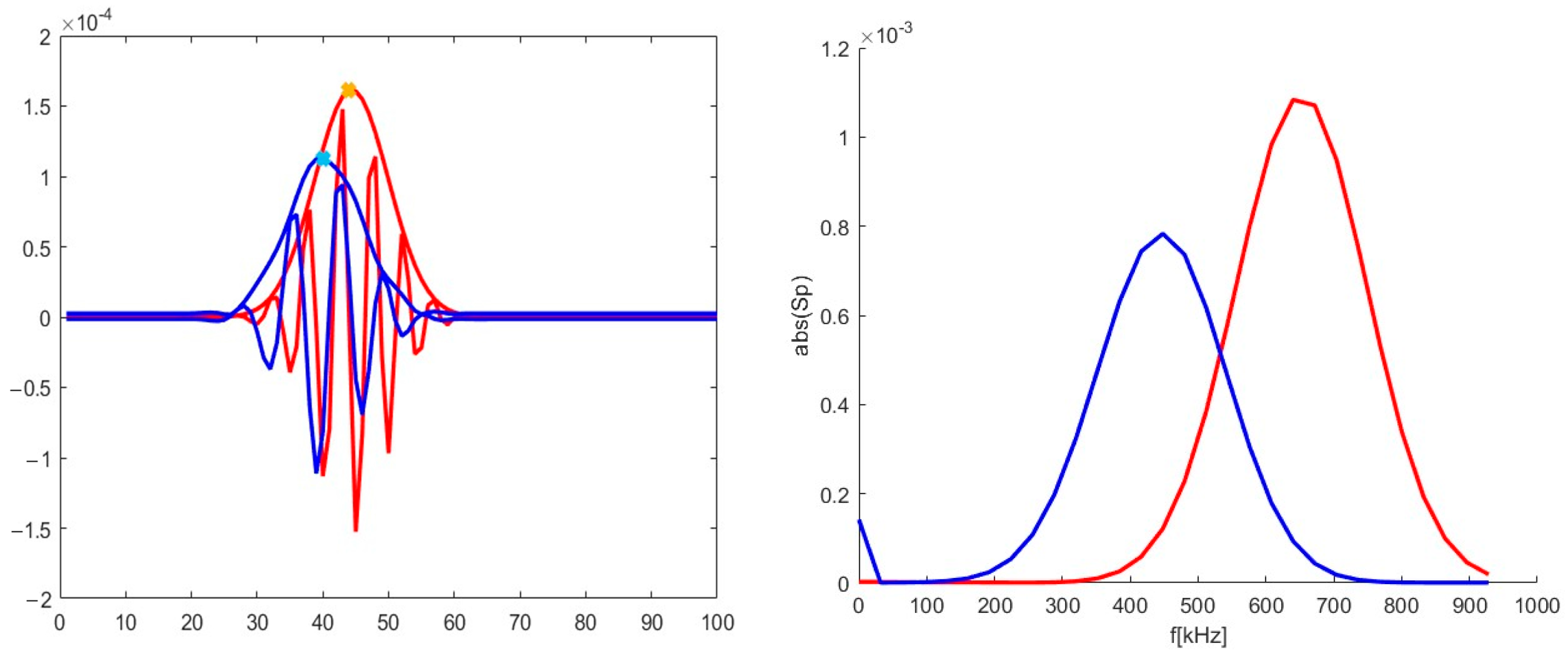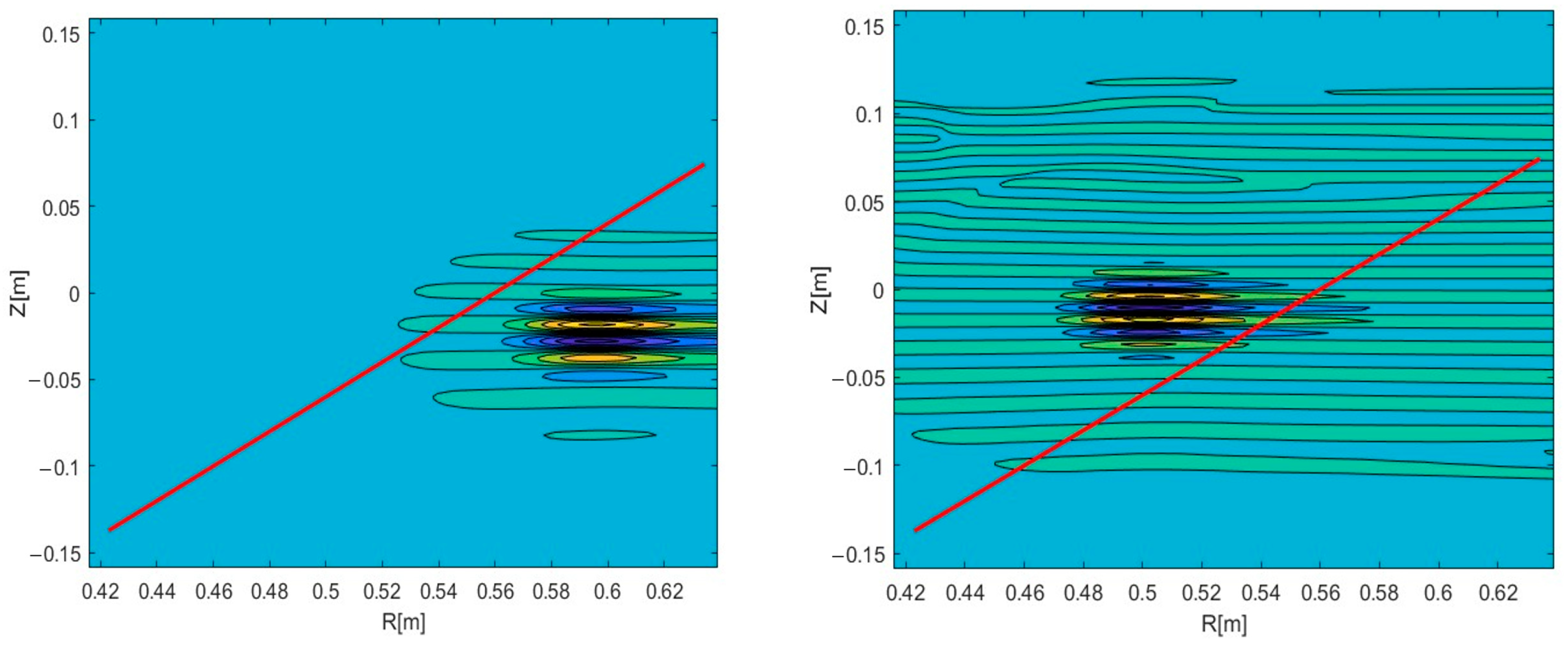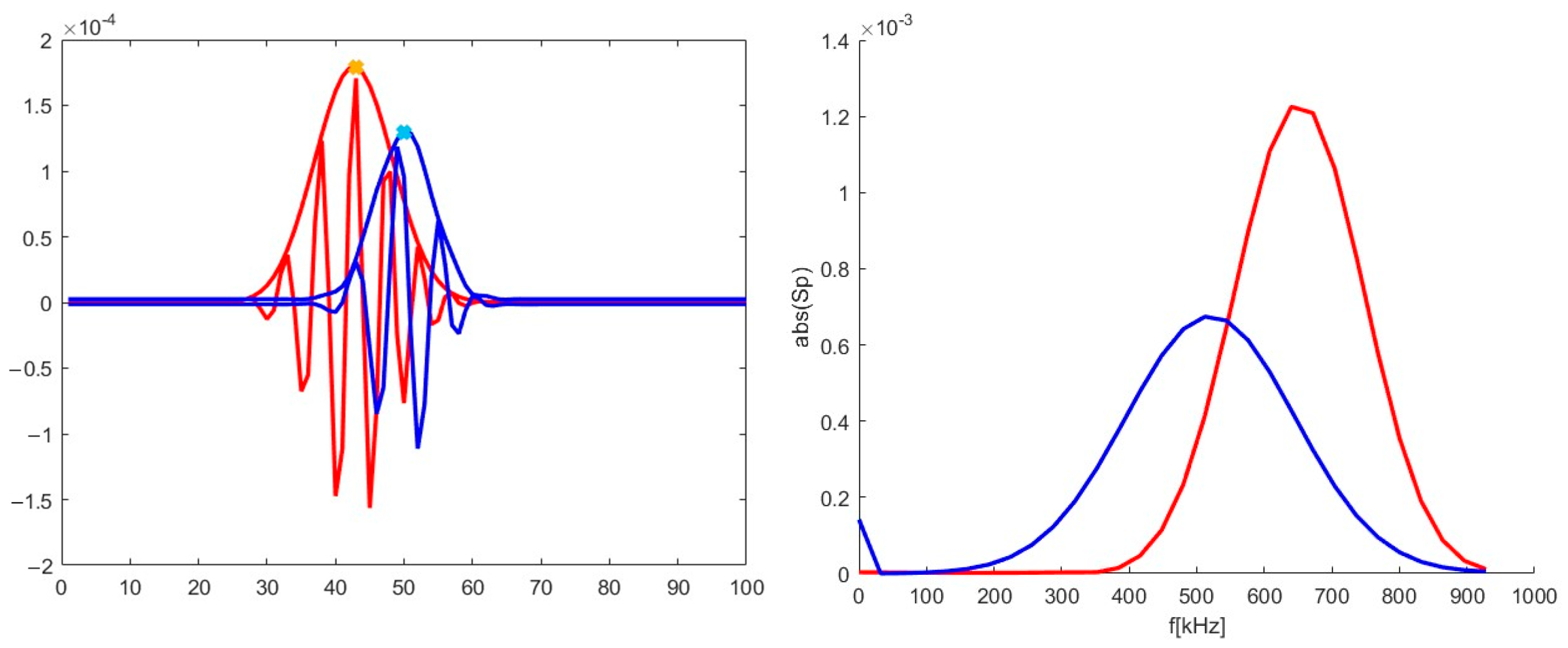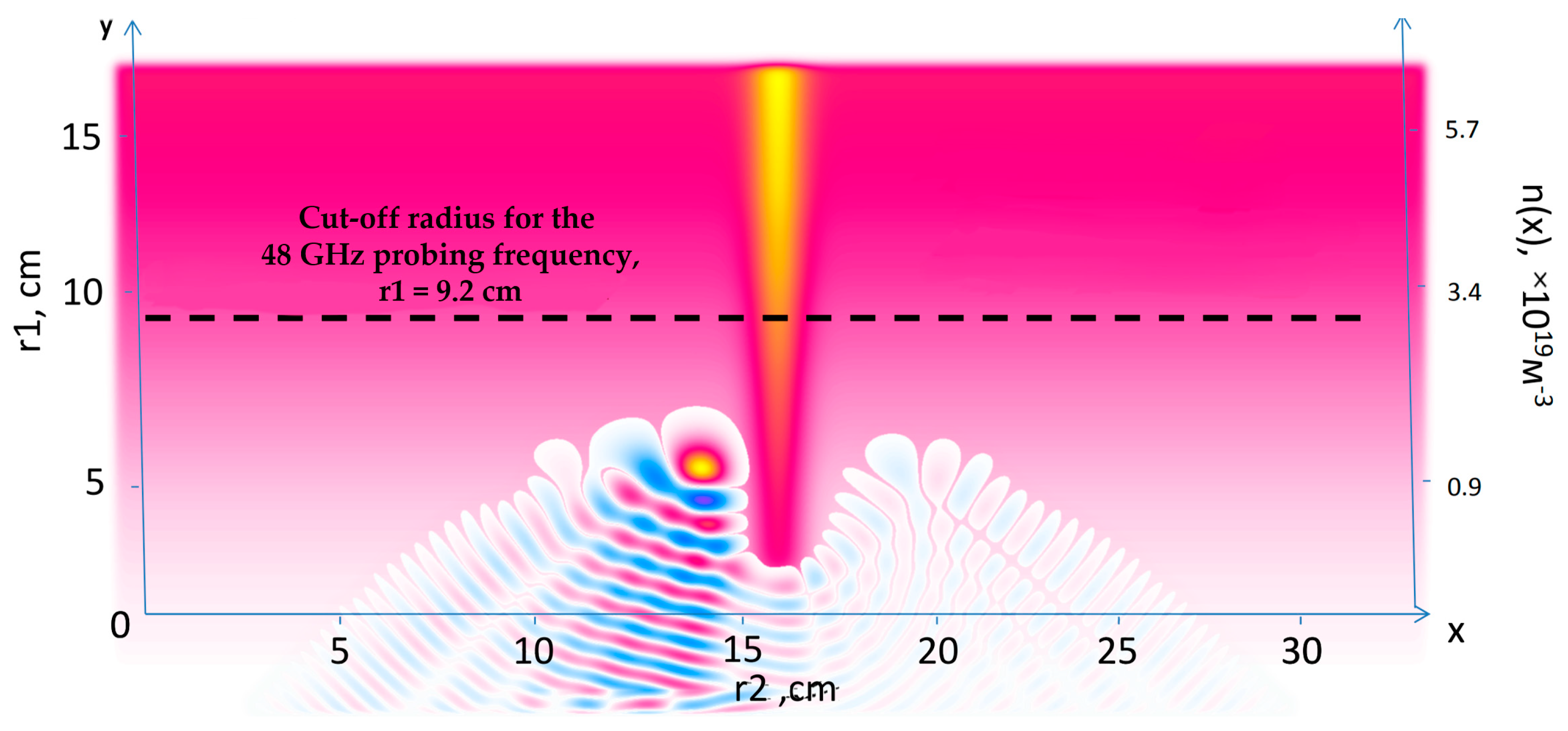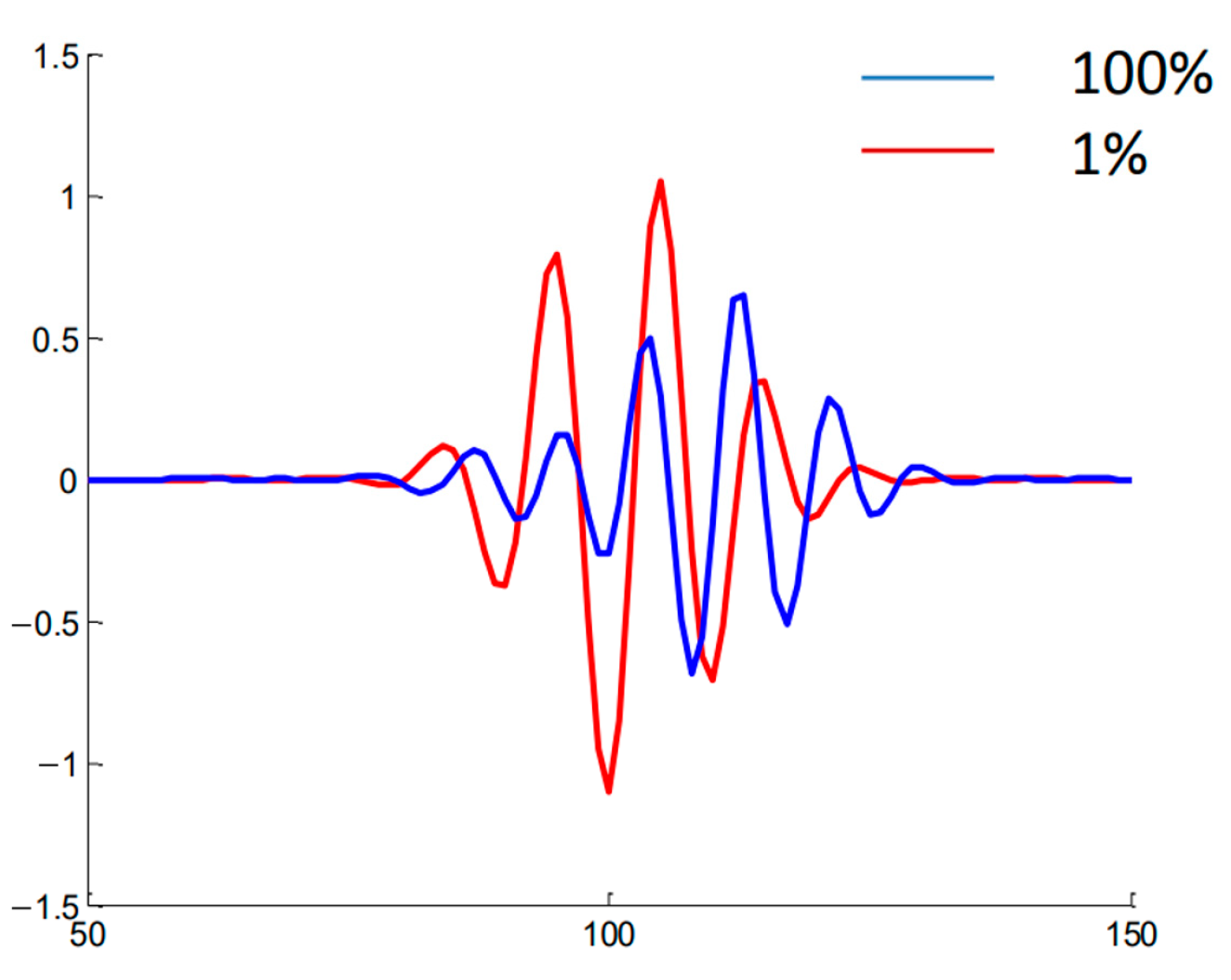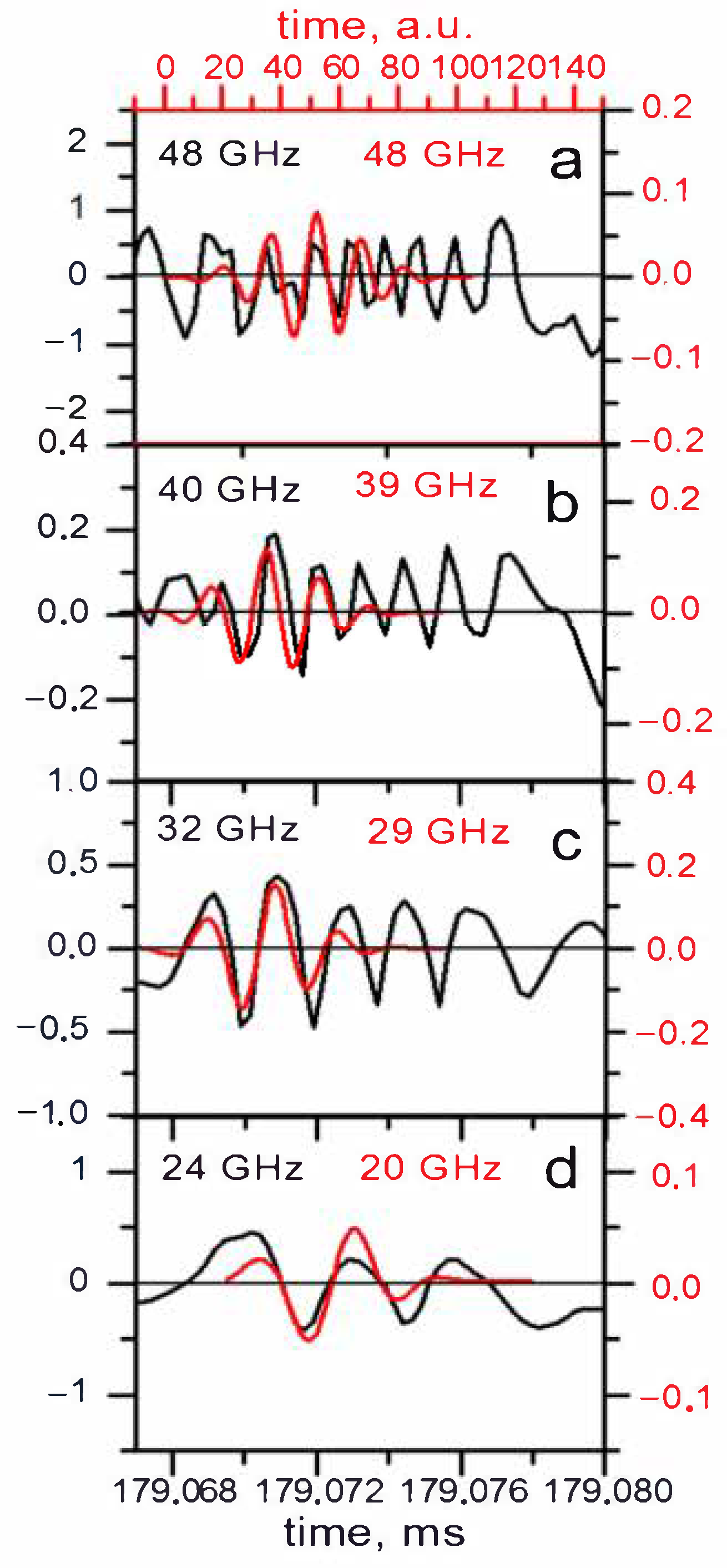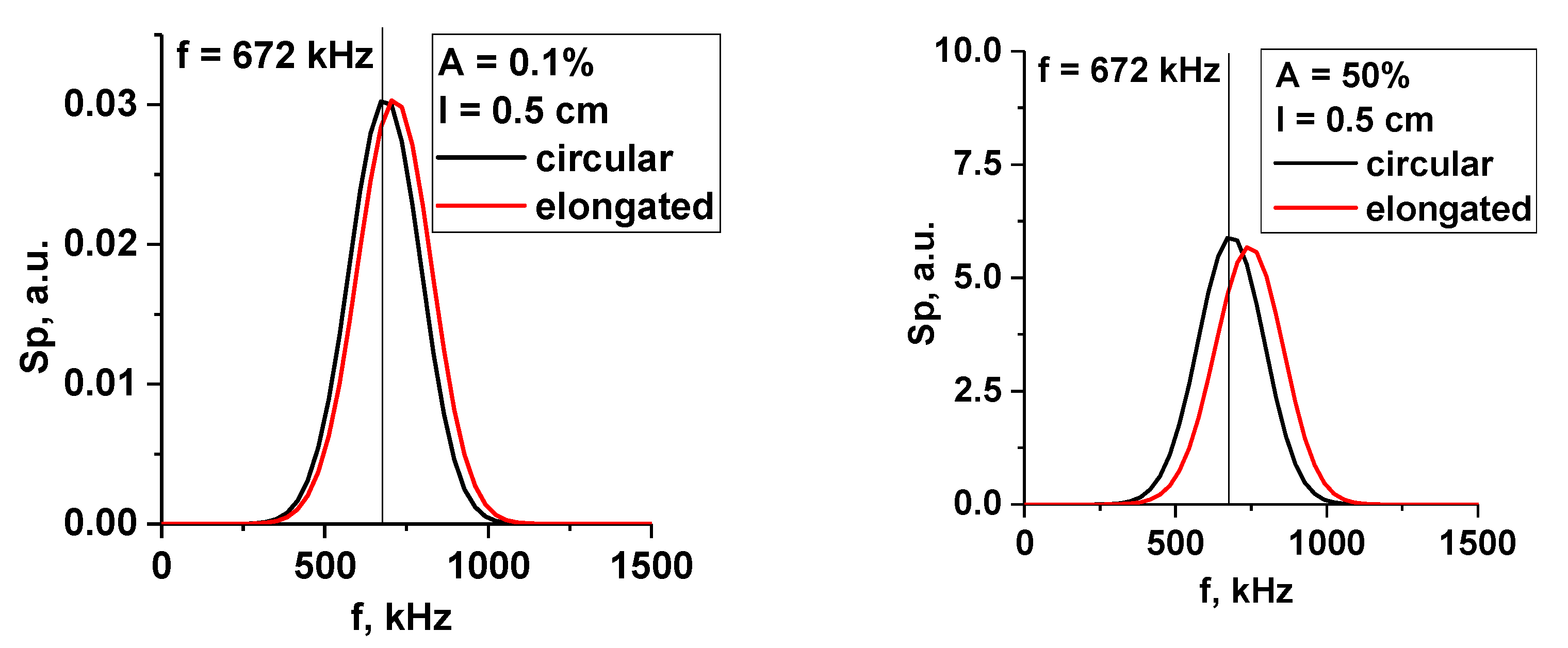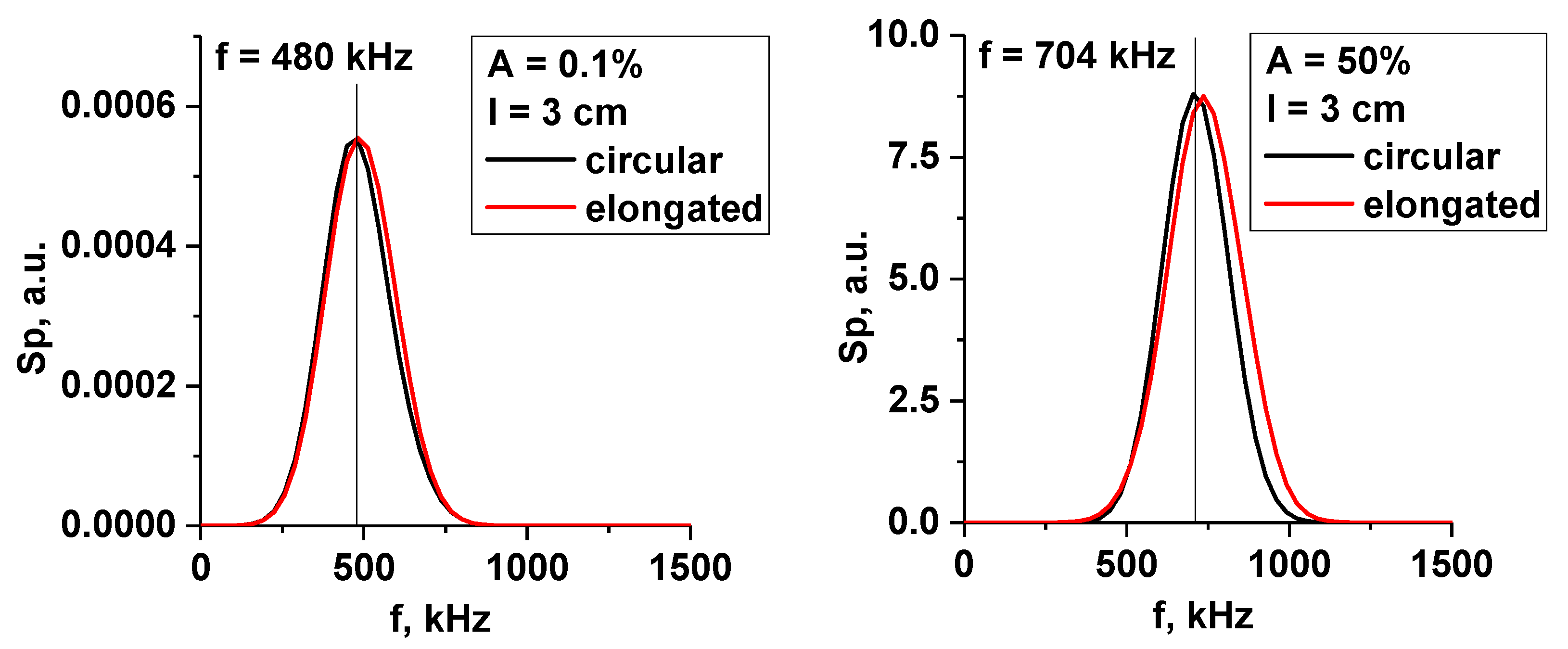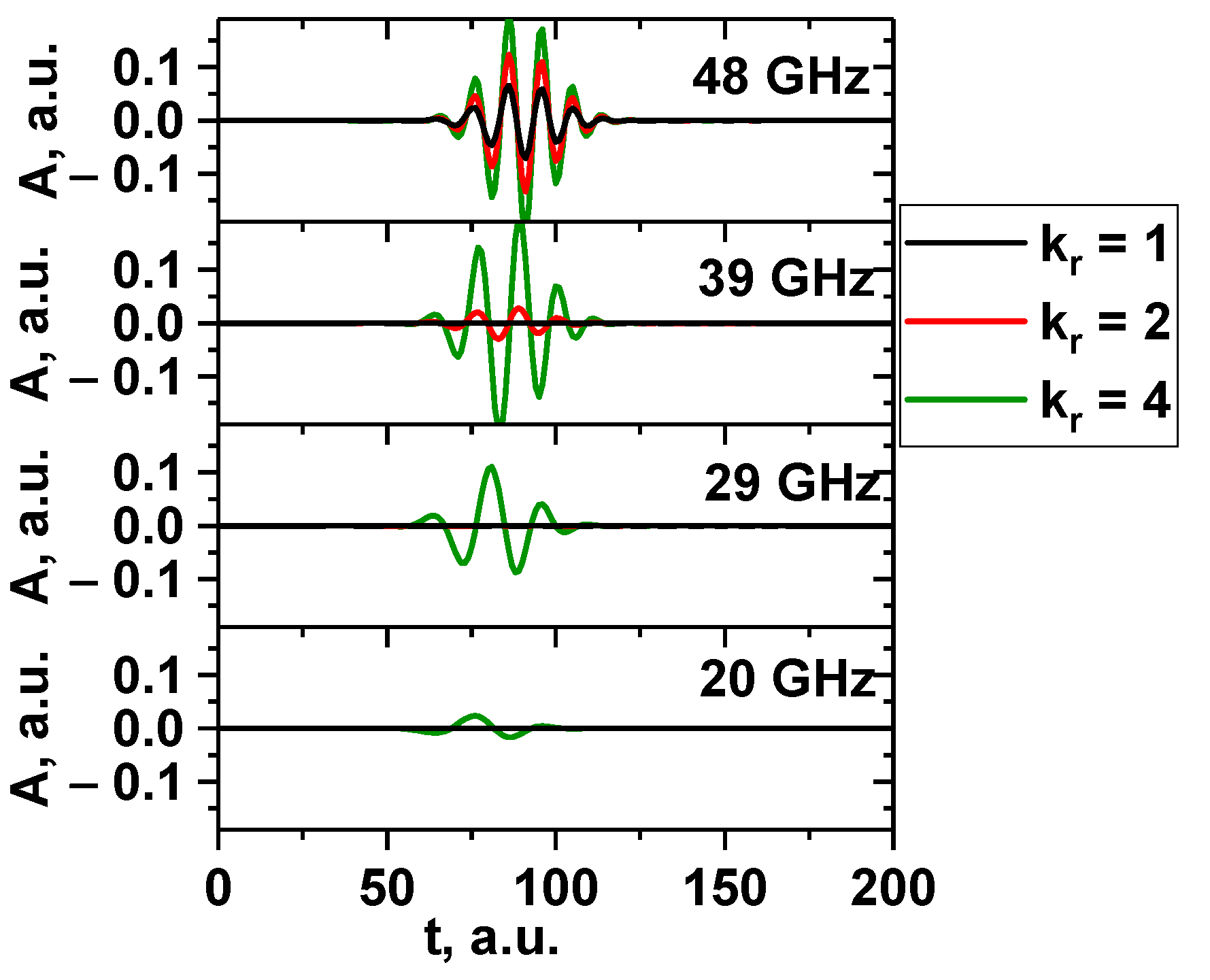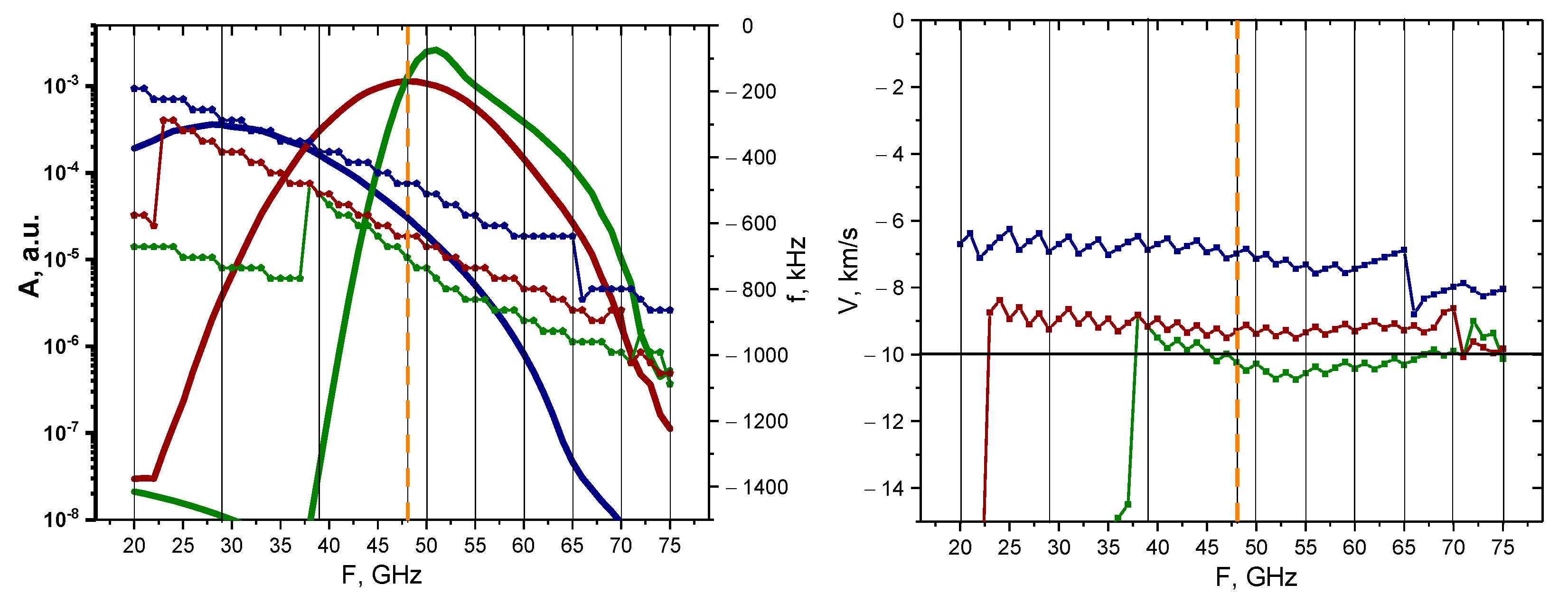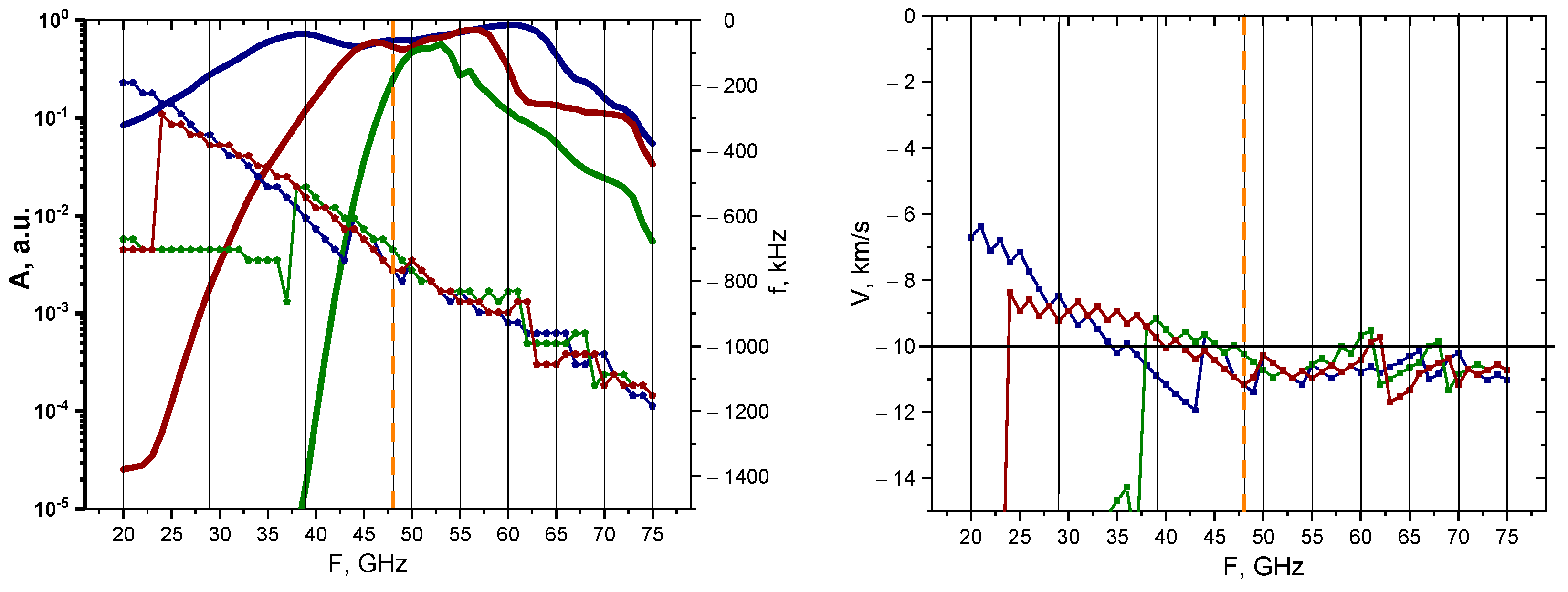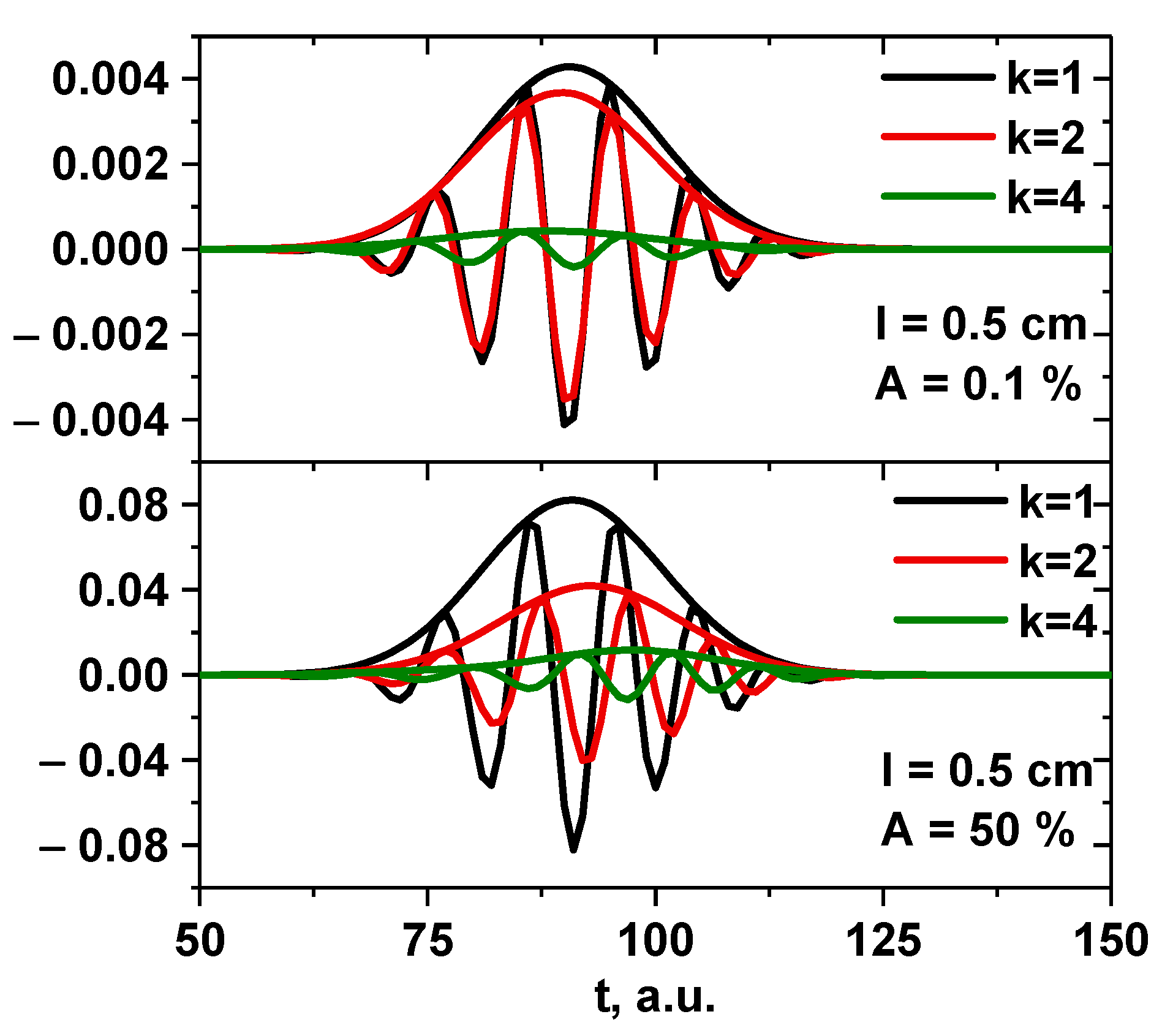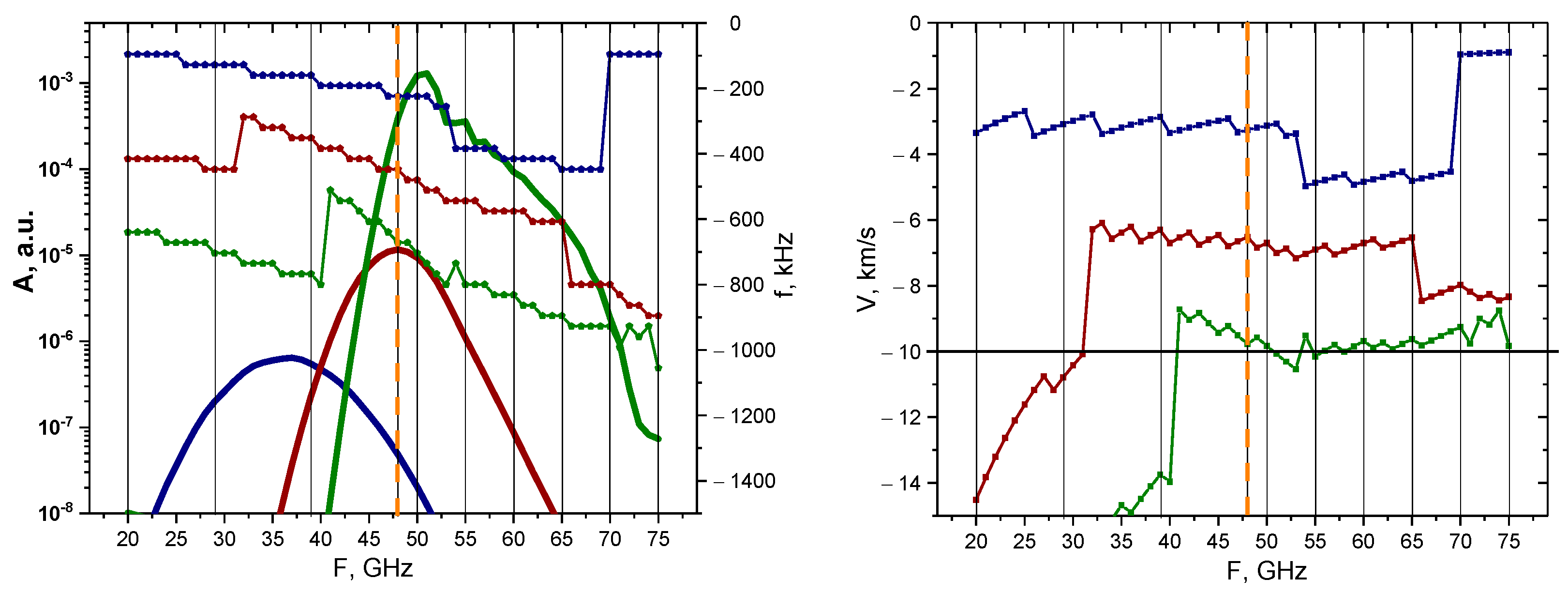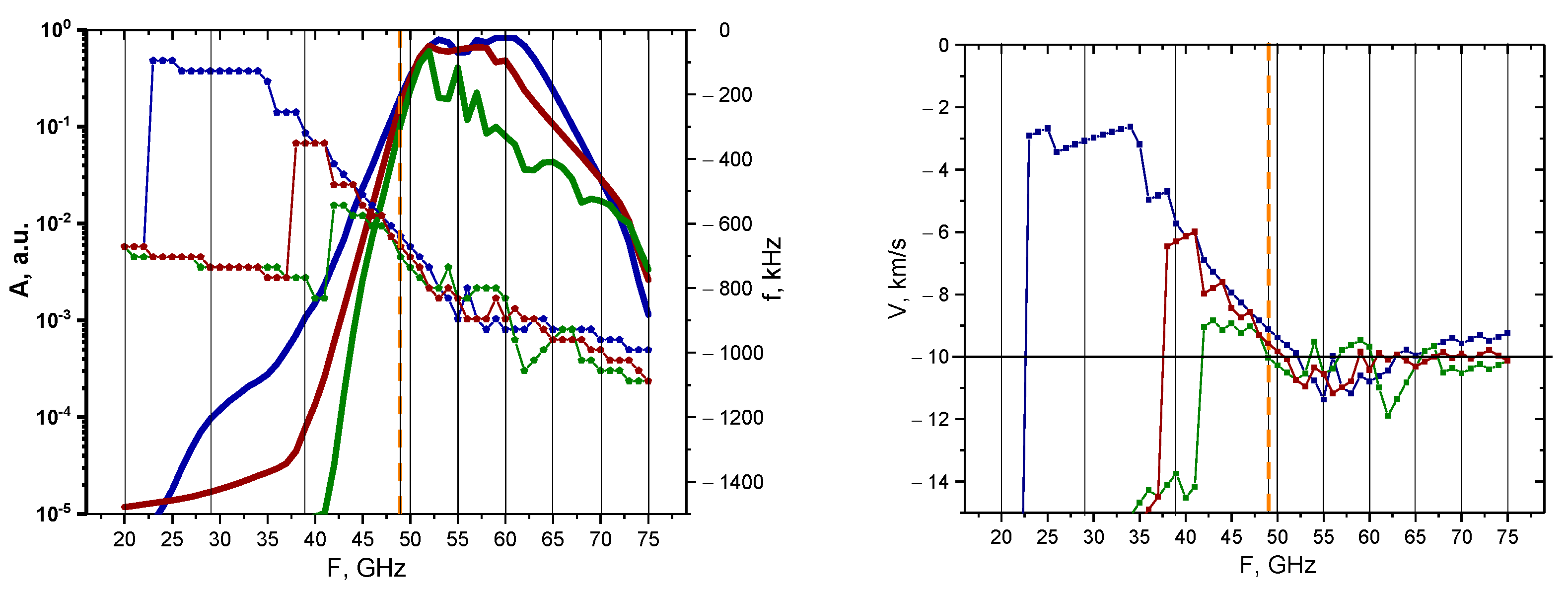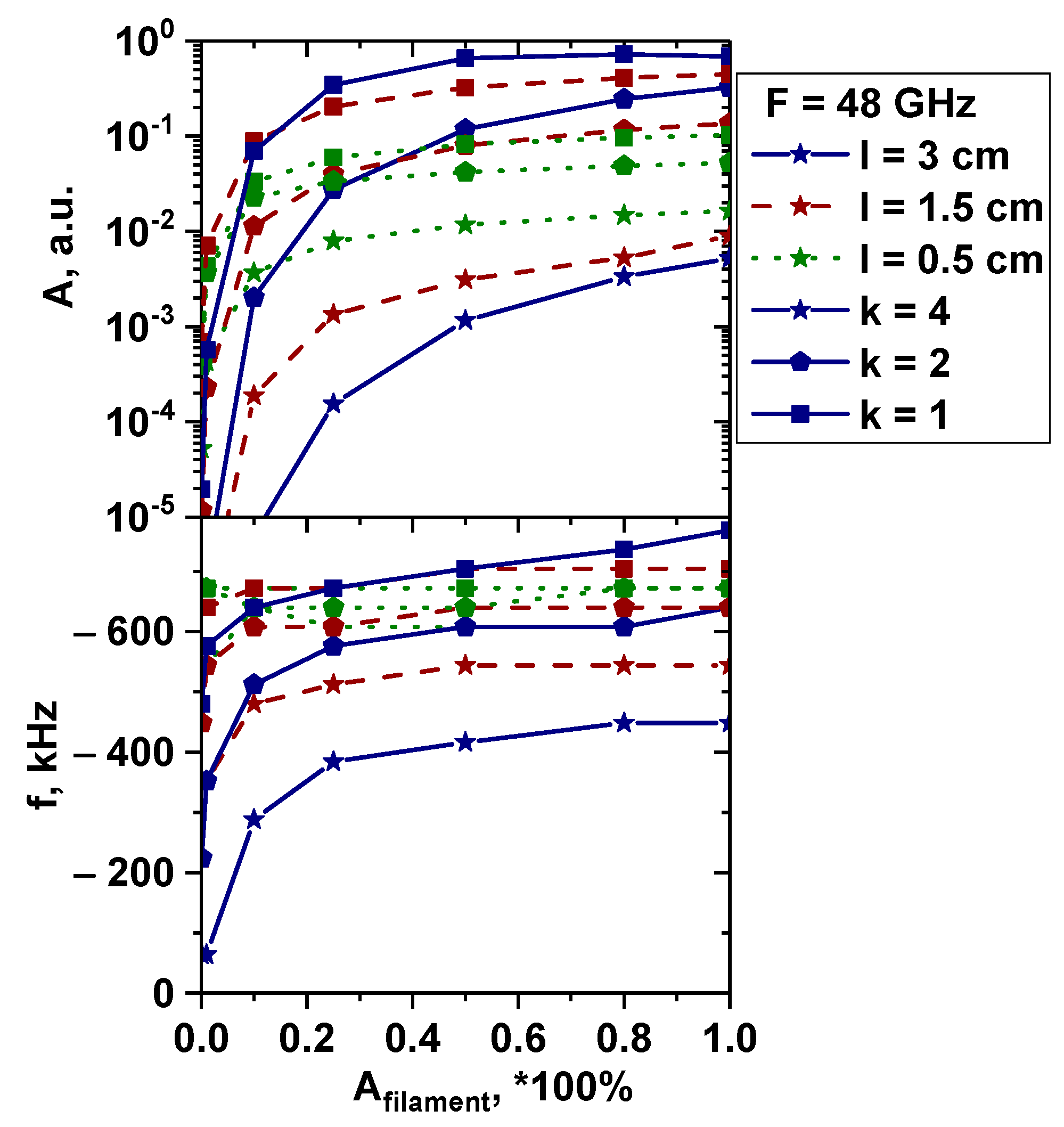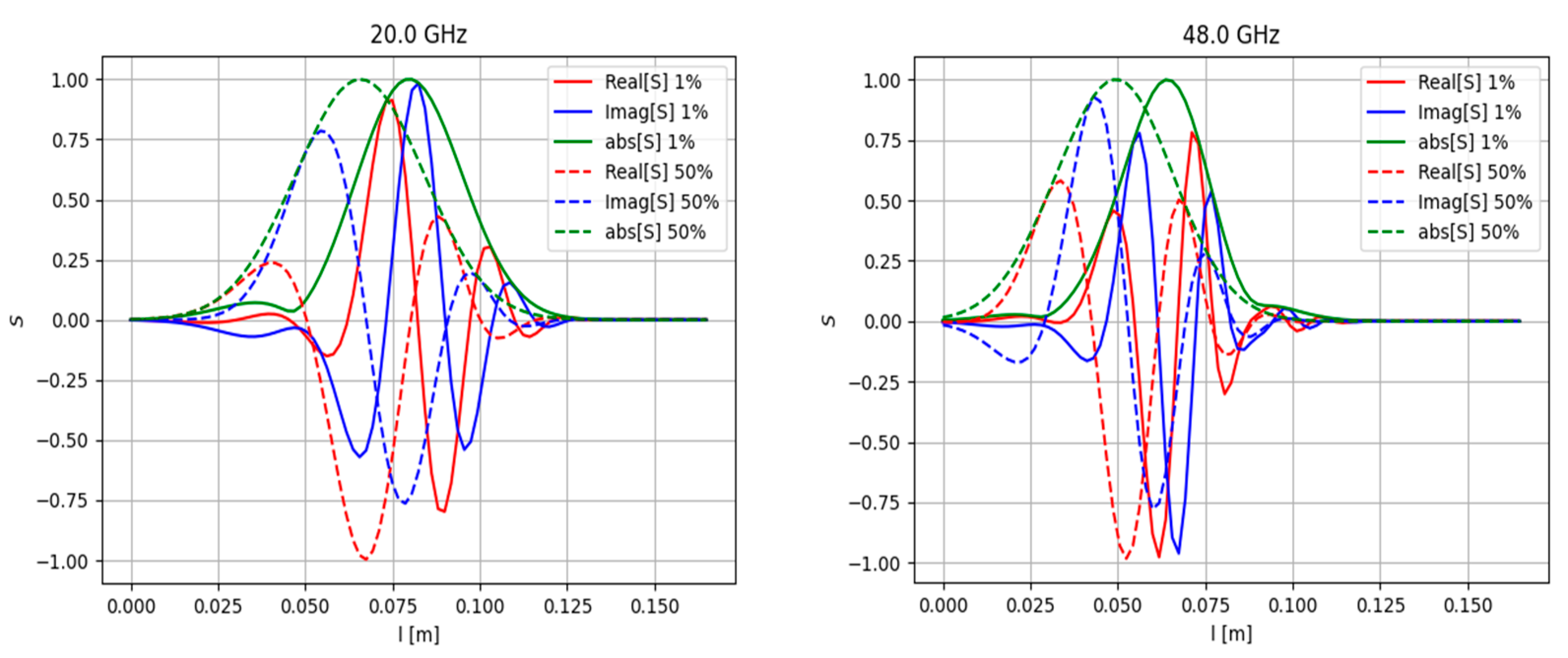Figure 1.
(left) Experimental electron density profile for Globus-M2, (right) experimental electron density profile for Globus-M2 with introduced filament distribution.
Figure 1.
(left) Experimental electron density profile for Globus-M2, (right) experimental electron density profile for Globus-M2 with introduced filament distribution.
Figure 2.
Poloidal cross-section of the Globus-M2 tokamak with performed ray tracing.
Figure 2.
Poloidal cross-section of the Globus-M2 tokamak with performed ray tracing.
Figure 3.
Schematics of DBS systems in Globus-M2.
Figure 3.
Schematics of DBS systems in Globus-M2.
Figure 4.
Density perturbations with an introduced circular filament (yellow circle).
Figure 4.
Density perturbations with an introduced circular filament (yellow circle).
Figure 5.
DBS signals for the 48 GHz probing frequency in the case of a circular filament of (left) 0.5 cm diameter and (right) 3 cm diameter. The black signals correspond to filaments with an amplitude of 1% of density at cutoff of the probing wave, and the red signals correspond to an amplitude of 100%.
Figure 5.
DBS signals for the 48 GHz probing frequency in the case of a circular filament of (left) 0.5 cm diameter and (right) 3 cm diameter. The black signals correspond to filaments with an amplitude of 1% of density at cutoff of the probing wave, and the red signals correspond to an amplitude of 100%.
Figure 6.
DBS IQ signals for the 48 GHz probing frequency for a circular filament with a 5 cm diameter: (left) amplitude of 1% of density at cutoff of the probing wave, (right) amplitude of 100% of density at cutoff of the probing wave.
Figure 6.
DBS IQ signals for the 48 GHz probing frequency for a circular filament with a 5 cm diameter: (left) amplitude of 1% of density at cutoff of the probing wave, (right) amplitude of 100% of density at cutoff of the probing wave.
Figure 7.
For the circular filament with an amplitude of 0.1%: (left) dependency of the DBS signal amplitude (bold lines with scale on the left) and frequency (lines with pentagon shapes with scale on the right) on the probing frequency; (right) dependency of the calculated velocity on the probing frequency. The navy-blue lines are the circular filament with a 3 cm diameter, the wine-red are that of 1.5 cm, and the olive-green are that of 0.5 cm. The black vertical lines indicate the probing frequencies available in Globus-M2, and the vertical orange dashed line indicates the position of the filament at cutoff of the 48 GHz probing wave. The horizontal line marks the set 10 km/s filament velocity.
Figure 7.
For the circular filament with an amplitude of 0.1%: (left) dependency of the DBS signal amplitude (bold lines with scale on the left) and frequency (lines with pentagon shapes with scale on the right) on the probing frequency; (right) dependency of the calculated velocity on the probing frequency. The navy-blue lines are the circular filament with a 3 cm diameter, the wine-red are that of 1.5 cm, and the olive-green are that of 0.5 cm. The black vertical lines indicate the probing frequencies available in Globus-M2, and the vertical orange dashed line indicates the position of the filament at cutoff of the 48 GHz probing wave. The horizontal line marks the set 10 km/s filament velocity.
Figure 8.
For the circular filament with an amplitude of 50%: (left) dependency of the DBS signal amplitude (bold lines with scale on the left) and frequency (lines with pentagon shapes with scale on the right) on the probing frequency; (right) dependency of the calculated velocity on the probing frequency. The navy-blue lines are the circular filament with a 3 cm diameter, the wine-red are that of 1.5 cm, and the olive-green are that of 0.5 cm. The black vertical lines indicate the probing frequencies available in Globus-M2, and the vertical orange dashed line indicates the position of the filament at cutoff of the 48 GHz probing wave. The horizontal line marks the set 10 km/s filament velocity.
Figure 8.
For the circular filament with an amplitude of 50%: (left) dependency of the DBS signal amplitude (bold lines with scale on the left) and frequency (lines with pentagon shapes with scale on the right) on the probing frequency; (right) dependency of the calculated velocity on the probing frequency. The navy-blue lines are the circular filament with a 3 cm diameter, the wine-red are that of 1.5 cm, and the olive-green are that of 0.5 cm. The black vertical lines indicate the probing frequencies available in Globus-M2, and the vertical orange dashed line indicates the position of the filament at cutoff of the 48 GHz probing wave. The horizontal line marks the set 10 km/s filament velocity.
Figure 9.
Density perturbations with an introduced series of circular filaments (yellow circles) positioned at different radii.
Figure 9.
Density perturbations with an introduced series of circular filaments (yellow circles) positioned at different radii.
Figure 10.
The dependency of the signal amplitude on the radial position of the circular filament of (left) 0.5 cm diameter and (right) 3 cm diameter. The red line corresponds to the filament with an amplitude of 1% of density at cutoff of the probing wave 48 GHz where the filament was positioned, and the black line corresponds to an amplitude of 100%.
Figure 10.
The dependency of the signal amplitude on the radial position of the circular filament of (left) 0.5 cm diameter and (right) 3 cm diameter. The red line corresponds to the filament with an amplitude of 1% of density at cutoff of the probing wave 48 GHz where the filament was positioned, and the black line corresponds to an amplitude of 100%.
Figure 11.
For the circular filament, the dependency of the signal amplitude (black line, scale on the left) and frequency (red line, scale on the right) on the radial position of the circular filament (left) with an amplitude of 1% of density at cutoff of the probing wave 48 GHz where the filament was positioned, and (right) a filament with an amplitude of 100%. The horizontal red line is the frequency predicted by the formula for the Doppler shift in the Born approximation.
Figure 11.
For the circular filament, the dependency of the signal amplitude (black line, scale on the left) and frequency (red line, scale on the right) on the radial position of the circular filament (left) with an amplitude of 1% of density at cutoff of the probing wave 48 GHz where the filament was positioned, and (right) a filament with an amplitude of 100%. The horizontal red line is the frequency predicted by the formula for the Doppler shift in the Born approximation.
Figure 12.
Two-dimensional DBS signal map for the circular filament positioned at the 48 GHz probing frequency. The red line indicates the trajectory: (left) poloidal motion, (middle) motion in both the poloidal and radial directions, (right) radial motion.
Figure 12.
Two-dimensional DBS signal map for the circular filament positioned at the 48 GHz probing frequency. The red line indicates the trajectory: (left) poloidal motion, (middle) motion in both the poloidal and radial directions, (right) radial motion.
Figure 13.
(left) DBS signal for the 48 GHz probing frequency; (right) calculated spectrum of the signal on the left.
Figure 13.
(left) DBS signal for the 48 GHz probing frequency; (right) calculated spectrum of the signal on the left.
Figure 14.
(
left) DBS signals for the 48 GHz probing frequency; (
right) calculated spectra of the signal on the left. The blue lines correspond to the reference signal from
Figure 13. The red lines correspond to the calculations for trajectory in the middle in
Figure 12.
Figure 14.
(
left) DBS signals for the 48 GHz probing frequency; (
right) calculated spectra of the signal on the left. The blue lines correspond to the reference signal from
Figure 13. The red lines correspond to the calculations for trajectory in the middle in
Figure 12.
Figure 15.
(
left) DBS signals for the 48 GHz probing frequency; (
right) calculated spectra of the signal on the left. The blue lines correspond to the reference signal from
Figure 13. The red lines correspond to the calculations for trajectory in
Figure 12.
Figure 15.
(
left) DBS signals for the 48 GHz probing frequency; (
right) calculated spectra of the signal on the left. The blue lines correspond to the reference signal from
Figure 13. The red lines correspond to the calculations for trajectory in
Figure 12.
Figure 16.
Two-dimensional DBS signal map for the circular filament positioned at the 48 GHz probing frequency: (left) 39 GHz, (right) 55 GHz probing frequency. The red line indicates the trajectory.
Figure 16.
Two-dimensional DBS signal map for the circular filament positioned at the 48 GHz probing frequency: (left) 39 GHz, (right) 55 GHz probing frequency. The red line indicates the trajectory.
Figure 17.
(left) DBS signals; (right) calculated spectra for the signal on the left. The blue lines correspond to the 39 GHz probing frequency, and the red lines correspond to 55 GHz.
Figure 17.
(left) DBS signals; (right) calculated spectra for the signal on the left. The blue lines correspond to the 39 GHz probing frequency, and the red lines correspond to 55 GHz.
Figure 18.
Two-dimensional DBS signal map for the circular filament positioned at the 48 GHz probing frequency: (left) 39 GHz; (right) 55 GHz probing frequency. The red line indicates the trajectory.
Figure 18.
Two-dimensional DBS signal map for the circular filament positioned at the 48 GHz probing frequency: (left) 39 GHz; (right) 55 GHz probing frequency. The red line indicates the trajectory.
Figure 19.
(left) DBS signals; (right) calculated spectra for the signal on the left. The blue lines correspond to the 39 GHz probing frequency, and the red line corresponds to 55 GHz.
Figure 19.
(left) DBS signals; (right) calculated spectra for the signal on the left. The blue lines correspond to the 39 GHz probing frequency, and the red line corresponds to 55 GHz.
Figure 20.
Density perturbations with an introduced strip filament (yellow vertical line). The electric field distribution is also presented.
Figure 20.
Density perturbations with an introduced strip filament (yellow vertical line). The electric field distribution is also presented.
Figure 21.
The DBS signal for the strip filament. Red line corresponds to the filament with an amplitude of 1% of density at cutoff of the probing wave 48 GHz where the filament was positioned, and the blue line corresponds to an amplitude of 100%.
Figure 21.
The DBS signal for the strip filament. Red line corresponds to the filament with an amplitude of 1% of density at cutoff of the probing wave 48 GHz where the filament was positioned, and the blue line corresponds to an amplitude of 100%.
Figure 22.
Experimental DBS signals (black lines) and calculated DBS signals for a strip filament model (red lines) for different probing frequencies.
Figure 22.
Experimental DBS signals (black lines) and calculated DBS signals for a strip filament model (red lines) for different probing frequencies.
Figure 23.
Filament density distribution: (left) radially stretched, (middle) circular, and (right) poloidally stretched filament.
Figure 23.
Filament density distribution: (left) radially stretched, (middle) circular, and (right) poloidally stretched filament.
Figure 24.
DBS signals (bold lines) and amplitude (regular lines) for the circular filament (black lines) and radially stretched filament (red lines): (left) filament amplitude of 0.1% of density at cutoff of the probing wave 48 GHz where the filament was positioned; (right) filament amplitude of 50%. Different filament diameters: (top) 0.5 cm, (middle) 1.5 cm, and (bottom) 3 cm.
Figure 24.
DBS signals (bold lines) and amplitude (regular lines) for the circular filament (black lines) and radially stretched filament (red lines): (left) filament amplitude of 0.1% of density at cutoff of the probing wave 48 GHz where the filament was positioned; (right) filament amplitude of 50%. Different filament diameters: (top) 0.5 cm, (middle) 1.5 cm, and (bottom) 3 cm.
Figure 25.
Spectrum of DBS signals for the 0.5 cm filament: (left) filament amplitude of 0.1% of density at cutoff of the probing wave 48 GHz where the filament was positioned; (right) amplitude of 50%. The black lines correspond to the circular filament, and the red lines correspond to the radially stretched filament.
Figure 25.
Spectrum of DBS signals for the 0.5 cm filament: (left) filament amplitude of 0.1% of density at cutoff of the probing wave 48 GHz where the filament was positioned; (right) amplitude of 50%. The black lines correspond to the circular filament, and the red lines correspond to the radially stretched filament.
Figure 26.
Spectrum of the DBS signals for the 3 cm filament: (left) filament amplitude of 0.1% of density at cutoff of the probing wave 48 GHz where the filament was positioned; (right) filament amplitude of 50%. The black lines correspond to the circular filament, and the red lines correspond to the radially stretched filament.
Figure 26.
Spectrum of the DBS signals for the 3 cm filament: (left) filament amplitude of 0.1% of density at cutoff of the probing wave 48 GHz where the filament was positioned; (right) filament amplitude of 50%. The black lines correspond to the circular filament, and the red lines correspond to the radially stretched filament.
Figure 27.
DBS signals for several probing frequencies. The circular (black line), slightly stretched with 1:2 proportions (red line), and very stretched with 1:4 proportions (green line) filaments are presented.
Figure 27.
DBS signals for several probing frequencies. The circular (black line), slightly stretched with 1:2 proportions (red line), and very stretched with 1:4 proportions (green line) filaments are presented.
Figure 28.
For the radially stretched filament with an amplitude of 0.1%: (left) dependency of the DBS signal amplitude (bold lines with scale on the left) and frequency (lines with pentagon shapes with scale on the right) on the probing frequency; (right) dependency of the calculated velocity on the probing frequency. The navy-blue lines are the circular filament with a 3 cm diameter, the wine-red are that of 1.5 cm, and the olive-green are that of 0.5 cm. The black vertical lines indicate the probing frequencies available in Globus-M2, and the vertical orange dashed line indicates the position of the filament at cutoff of the 48 GHz probing wave. The horizontal line marks the set 10 km/s filament velocity.
Figure 28.
For the radially stretched filament with an amplitude of 0.1%: (left) dependency of the DBS signal amplitude (bold lines with scale on the left) and frequency (lines with pentagon shapes with scale on the right) on the probing frequency; (right) dependency of the calculated velocity on the probing frequency. The navy-blue lines are the circular filament with a 3 cm diameter, the wine-red are that of 1.5 cm, and the olive-green are that of 0.5 cm. The black vertical lines indicate the probing frequencies available in Globus-M2, and the vertical orange dashed line indicates the position of the filament at cutoff of the 48 GHz probing wave. The horizontal line marks the set 10 km/s filament velocity.
Figure 29.
For the radially stretched filament with an amplitude of 50%: (left) dependency of the DBS signal amplitude (bold lines with scale on the left) and frequency (lines with pentagon shapes with scale on the right) on the probing frequency; (right) dependency of the calculated velocity on the probing frequency. The navy-blue lines are the circular filament with a 3 cm diameter, the wine-red are that of 1.5 cm, and the olive-green are that of 0.5 cm. The black vertical lines indicate the probing frequencies available in Globus-M2, and the vertical orange dashed line indicates the position of the filament at cutoff of the 48 GHz probing wave. The horizontal line marks the set 10 km/s filament velocity.
Figure 29.
For the radially stretched filament with an amplitude of 50%: (left) dependency of the DBS signal amplitude (bold lines with scale on the left) and frequency (lines with pentagon shapes with scale on the right) on the probing frequency; (right) dependency of the calculated velocity on the probing frequency. The navy-blue lines are the circular filament with a 3 cm diameter, the wine-red are that of 1.5 cm, and the olive-green are that of 0.5 cm. The black vertical lines indicate the probing frequencies available in Globus-M2, and the vertical orange dashed line indicates the position of the filament at cutoff of the 48 GHz probing wave. The horizontal line marks the set 10 km/s filament velocity.
Figure 30.
DBS signals for circular (black line), slightly poloidally stretched with 1:2 proportions (red line), and very poloidally stretched with 1:4 proportions (green line) filaments of 0.5 cm diameter: (top) amplitude of 0.1% of density at cutoff of the probing wave 48 GHz where the filament was positioned; (bottom) amplitude of 50%.
Figure 30.
DBS signals for circular (black line), slightly poloidally stretched with 1:2 proportions (red line), and very poloidally stretched with 1:4 proportions (green line) filaments of 0.5 cm diameter: (top) amplitude of 0.1% of density at cutoff of the probing wave 48 GHz where the filament was positioned; (bottom) amplitude of 50%.
Figure 31.
For the poloidally stretched filament with an amplitude of 0.1%: (left) dependency of the DBS signal amplitude (bold lines with scale on the left) and frequency (lines with pentagon shapes with scale on the right) on the probing frequency; (right) dependency of the calculated velocity on the probing frequency. The navy-blue lines are the circular filament with a 3 cm diameter, the wine-red are that of 1.5 cm, and the olive-green are that of 0.5 cm. The black vertical lines indicate the probing frequencies available in Globus-M2, and the vertical orange dashed line indicates the position of the filament at cutoff of the 48 GHz probing wave. The horizontal line marks the set 10 km/s filament velocity.
Figure 31.
For the poloidally stretched filament with an amplitude of 0.1%: (left) dependency of the DBS signal amplitude (bold lines with scale on the left) and frequency (lines with pentagon shapes with scale on the right) on the probing frequency; (right) dependency of the calculated velocity on the probing frequency. The navy-blue lines are the circular filament with a 3 cm diameter, the wine-red are that of 1.5 cm, and the olive-green are that of 0.5 cm. The black vertical lines indicate the probing frequencies available in Globus-M2, and the vertical orange dashed line indicates the position of the filament at cutoff of the 48 GHz probing wave. The horizontal line marks the set 10 km/s filament velocity.
Figure 32.
For the poloidally stretched filament with an amplitude of 50%: (left) dependency of the DBS signal amplitude (bold lines with scale on the left) and frequency (lines with pentagon shapes with scale on the right) on the probing frequency; (right) dependency of the calculated velocity on the probing frequency. The navy-blue lines are the circular filament with a 3 cm diameter, the wine-red are that of 1.5 cm, and the olive-green are that of 0.5 cm. The black vertical lines indicate the probing frequencies available in Globus-M2, and the vertical orange dashed line indicates the position of the filament at cutoff of the 48 GHz probing wave. The horizontal line marks the set 10 km/s filament velocity.
Figure 32.
For the poloidally stretched filament with an amplitude of 50%: (left) dependency of the DBS signal amplitude (bold lines with scale on the left) and frequency (lines with pentagon shapes with scale on the right) on the probing frequency; (right) dependency of the calculated velocity on the probing frequency. The navy-blue lines are the circular filament with a 3 cm diameter, the wine-red are that of 1.5 cm, and the olive-green are that of 0.5 cm. The black vertical lines indicate the probing frequencies available in Globus-M2, and the vertical orange dashed line indicates the position of the filament at cutoff of the 48 GHz probing wave. The horizontal line marks the set 10 km/s filament velocity.
Figure 33.
The dependency of the (top) signal amplitude and (bottom) signal frequency on filament amplitude. The blue lines correspond to 3 cm diameter filaments, the red lines correspond to 1.5 cm, and the green lines correspond to 0.5 cm. The lines with the squares correspond to the circular filament, the lines with pentagon shapes—poloidally stretched filament with proportions of 1:2, and the lines with stars—poloidally stretched filament with proportions of 1:4.
Figure 33.
The dependency of the (top) signal amplitude and (bottom) signal frequency on filament amplitude. The blue lines correspond to 3 cm diameter filaments, the red lines correspond to 1.5 cm, and the green lines correspond to 0.5 cm. The lines with the squares correspond to the circular filament, the lines with pentagon shapes—poloidally stretched filament with proportions of 1:2, and the lines with stars—poloidally stretched filament with proportions of 1:4.
Figure 34.
Experimental electron density profile for Globus-M2.
Figure 34.
Experimental electron density profile for Globus-M2.
Figure 35.
The dependency of the signal amplitude on different probing frequencies for the high-density profile from
Figure 1 (dashed lines) and low-density profile from
Figure 34 (regular lines): (
left) filaments with an amplitude of 0.1% of density at cutoff of the probing wave 48 GHz where the filament was positioned; (
right) filament with an amplitude of 50%. The blue lines correspond to 3 cm diameter filaments, the red lines correspond to 1.5 cm, and the green lines correspond to 0.5 cm. Different proportions of stretching of the filaments are presented in the figure.
Figure 35.
The dependency of the signal amplitude on different probing frequencies for the high-density profile from
Figure 1 (dashed lines) and low-density profile from
Figure 34 (regular lines): (
left) filaments with an amplitude of 0.1% of density at cutoff of the probing wave 48 GHz where the filament was positioned; (
right) filament with an amplitude of 50%. The blue lines correspond to 3 cm diameter filaments, the red lines correspond to 1.5 cm, and the green lines correspond to 0.5 cm. Different proportions of stretching of the filaments are presented in the figure.
Figure 36.
DBS signals calculated for the real Globus-M geometry (left) for the 20 GHz probing frequency and (right) for 48 GHz frequency. The regular lines correspond to filaments with amplitudes of 1% of density at cutoff of the probing wave, and the dashed lines correspond to filaments with amplitudes of 50% of density at cutoff of the probing wave.
Figure 36.
DBS signals calculated for the real Globus-M geometry (left) for the 20 GHz probing frequency and (right) for 48 GHz frequency. The regular lines correspond to filaments with amplitudes of 1% of density at cutoff of the probing wave, and the dashed lines correspond to filaments with amplitudes of 50% of density at cutoff of the probing wave.
Table 1.
Parameters of the performed modelling using the code IPF-FD3D.
Table 1.
Parameters of the performed modelling using the code IPF-FD3D.
| Box size | 40 × 24 cm = 1538 × 923 pts |
| Step size | dx = 1 pt = 0.026 cm |
| Equatorial plane | X = 10 cm = 384 pts |
| PML | Y = 0.625 cm = 24 pts |
| Plasma edge | Y = 2.08 cm |
| Antenna coordinates | X = 4 cm = 154, Y = 0 |
| Antenna tilt angle | 6 deg |
| Horn mouth | 5.5 cm |
| Wave front | flat, Gaussian beam, w0 = 2.5 cm, z0 = 0 |
Table 2.
Parameters of the performed modelling for circular filaments.
Table 2.
Parameters of the performed modelling for circular filaments.
| Frequencies | 20, 29, 39, 48, 50, 55, 60, 65, 70, 75 GHz |
| Antenna tilt angle | 13 degrees |
| Horn mouth | 5.5 |
| Wave front | flat |
| Diameter of the filament | 0.5 cm, 1.5 cm, 3 cm |
| Amplitude of the filament | 0.1%, 1%, 10%, 25%, 50%, 80%, 100% |
| Position of the filament | In the vicinity of the cut off 48 GHZ |
Table 3.
Parameters of the performed modelling for the motion of circular filaments.
Table 3.
Parameters of the performed modelling for the motion of circular filaments.
| Frequencies | 48 GHz |
| Antenna tilt angle | 13 degrees |
| Horn mouth | 5.5 |
| Wave front | flat |
| Diameter of the filament | 0.5 cm, 1 cm, 1.5 cm, 5 cm |
| Amplitude of the filament | 0.1%, 1%, 5%, 10%, 50%, 75%, 100% |
| Position of the filament | 4 cm, 6 cm, 8 cm, 10 cm, 12 cm |
Table 4.
Parameters of the performed modelling for the strip filament.
Table 4.
Parameters of the performed modelling for the strip filament.
| Frequencies | 30, 35, 40, 45, 50, 55, 60, 65, 70, 75 GHz |
| Antenna tilt angle | 13 deg |
| Horn mouth | 5.5 cm |
| Wave front | flat |
| Diameter of the filament | 0.5 cm, 1 cm, 1.5 cm, 3 cm, 5 cm, 6 cm |
| Amplitude of the filament | 0.1%, 1%, 5%, 10%, 20%, 30%, 40%, 50%, 60%, 70%, 80%, 90%, 100%, 110%, 150% |
| Position of the filament | In the vicinity of the cut off |
Table 5.
Parameters of the performed modelling for the stretched filament.
Table 5.
Parameters of the performed modelling for the stretched filament.
| Frequencies | 20, 29, 39, 48, 50, 55, 60, 65, 70, 75 GHz |
| Antenna tilt angle | 13 deg |
| Horn mouth | 5.5 cm |
| Wave front | flat |
| Diameter of the filament | 0.5 cm, 1.5 cm, 3 cm |
| Amplitude of the filament | 0.1%, 1%, 10%, 25%, 50%, 80%, 100% |
| Position of the filament | In the vicinity of the cut off |


